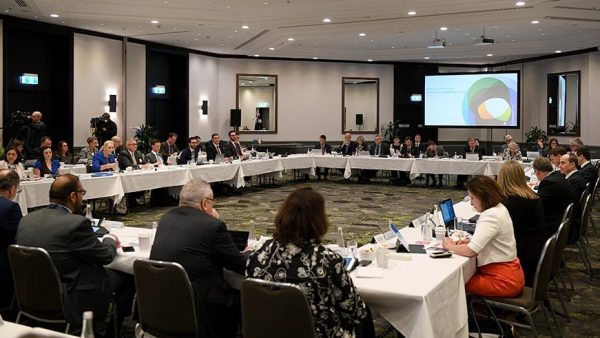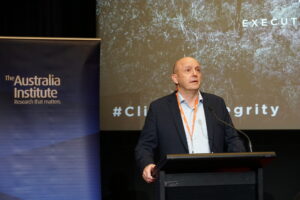
Today the federal, state and territory energy ministers will meet to discuss a range of proposed, clean energy-based redesigns of the National Electricity Market (NEM), prepared by the Energy Security Board (ESB).
While Barnaby Joyce may still want to see what’s on the climate action ‘menu’, we know already that the Prime Minister’s easiest path to emissions reduction would be to reform the energy market in a way that allows renewables to crowd-out coal.
Institutional investors and millions of households are already building and installing the new solar, wind and batteries that will power the grid of the future.
All the federal government has to do is accelerate the redesign of the electricity system so that it is secure and reliable when coal power stations inevitably retire or fail.
In May the coal-fired Callide C power station in Queensland exploded. This caused cascading failures at Callide B, Stanwell and Gladstone coal power stations.
A month later it was Victoria’s turn when the Yallourn power station flooded, leading the government to declare a state energy emergency.
The Australian Energy Regulator has reported an incredible 1,000 days of “baseload outages” in the second quarter of this financial year.
As the climate crisis worsens and our aging coal fleet falters, there is a clear and urgent need to build a future-proof electricity system that is able to operate securely without fossil fuels.
The Australian Energy Market Operator recently announced that the NEM will be able to operate safely on 100% renewable energy for brief periods by 2025.
The primary challenge of the clean energy transition is political, not technical. Federal energy and emissions minister Angus Taylor has consistently undermined clean energy reform of the NEM and promoted subsidies for gas and coal.
Taylor has twice tried to sack the Board and terminate its reform project. Progressive Liberal energy ministers in NSW and SA teamed up with Labor and Green ministers to keep the reform process going.
Last month the ESB finished the “Post-2025” project and the redesign recommendations were sent to ministers. Taylor seems to be using ‘cabinet-in-confidence’ to control information about the reform process, even though they are not cabinet documents.
The federal government tasked the ESB’s work to the Energy National Cabinet Reform Committee. The problem is that the Administrative Appeals Tribunal recently ruled that the National Cabinet is not a committee of the federal cabinet and therefore not subject to confidentiality. Yet minister Taylor is yet to release the reform recommendations the public.
Bizarrely, Taylor has been campaigning on his preferred ESB recommendation, while at the same time keeping the paper secret. Other ministers are respecting the supposed confidentiality of the process that he is undermining.
Australia Institute research has shown that the policy Taylor supports would create a new market to prop up failing coal power stations and would be bad for consumers. It has been widely condemned by environmentalists and renewables companies.
It makes no sense to supposedly safeguard the NEM by forcing consumers to pay in advance for baseload that is out of action at a rate of 1000 days per quarter.
Imagine if the federal government banked on its coal capacity market to get Australia through a long hot summer and the outage rate was even higher.
For two and half years, hundreds of energy experts from across the industry, stakeholder groups and the research sector have worked with the ESB on the NEM redesign. Millions of dollars worth of effort has been expended.
Now nobody knows when the reform recommendations will be made public or when ministers will make their final decisions.
This policy uncertainty is delaying investment, which pushes up the cost of energy. It is bad for the economy and makes it harder for the Prime Minister to commit to deeper emissions reductions.
The states are stepping up while the federal government fails to lead. States are committing to carbon emissions reduction targets while building out massive Renewable Energy Zones. But they need to do more.
In the immediate-term, the report the states and commonwealth commissioned from the ESB should be made public immediately. It is policy advice to government, not a cabinet document.
In the short-term, the states must agree to schedule the orderly retirement of their remaining coal generators.
In the medium-term, they should draw on constructive recommendations from the ESB to procure the security services and energy resources required to safely manage that phase-out.
It is regrettable, but just as the states have led in Australia’s response to the COVID-19 crisis, they must now step in once again and save the NEM reform process from the clumsy mishandling of the federal government.
Between the Lines Newsletter
The biggest stories and the best analysis from the team at the Australia Institute, delivered to your inbox every fortnight.
You might also like
Labor’s pledge to depoliticise the public service is undermined by the government only hearing what it wants to hear on climate change
While last year’s robodebt royal commission exposed a shocking lack of ethics among senior ranks of the Australian public service, the systemic condition still largely seems to be regarded as an aberration.
Opening Remarks: Climate Integrity Summit | Richard Denniss
If we wanted to fix these things, we could. If you think that we need some complicated policy measure or some very expensive investment, you’ve been misled.
Corporate Profits Must Take Hit to Save Workers
Historically high corporate profits must take a hit if workers are to claw back real wage losses from the inflationary crisis, according to new research from the Australia Institute’s Centre for Future Work.

